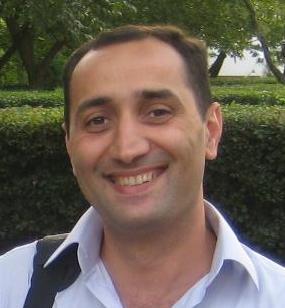Support member
名前と所属

研究アドミニストレータ:Eldar Mammadov(エルダー ママドフ) 学歴:
1991年〜1996年 1991-1996 Diploma in Physics Baku State University, Baku, Azerbaijan
1998年〜2001年 1998-2001 Post-graduate courses, Institute of Physics, ANAS
2006年 Candidate of Physical and Mathematical Sciences (doctorate)
Institute of Physics, Azerbaijan National Academy of Sciences (ANAS)
職歴:
1996年〜2003年 Junior Research Assistant, Institute of Physics,
Azerbaijan National Academy of Sciences
2002年6月〜2004年6月 Visiting Research Scholar, Ioffe Physico-Technical Institute,
St. Petersburg, Russia
2003年〜2006年 Scientific Associate, Institute of Physics,
Azerbaijan National Academy of Sciences
2006年〜2007年 Postdoctoral Researcher, Physics Department,
Colorado School of Mines, Golden, CO, USA.
2007年〜2009年 Visiting Researcher, Condensed Matter NMR Group,
National High Magnetic Field Lab, Tallahassee, FL, USA
2009年〜present Lead Research Fellow, Institute of Physics, ANAS
2010年4月〜 Visiting Research Fellow, Department of Electrical Engineering/
Electronic Devices and Optical Electronics group,
Nagaoka University of Technology, Japan
Research Interests
The major research interests include the optical, electronic and structural properties of crystalline and amorphous semiconductors.
Current topics under investigation include localized electronic states in ternary semiconductors, electronic and optical properties of chalcogenide glasses for phase-change memory applications,
local structural order in ternary and multinary semiconductors, structure-properties correlations in complex amorphous semiconductors,
origin of anomalous photoluminescence in Mn-doped ZnSnAs2.
One very important research topic in modern condensed-matter physics is the relationship between local structural order and electronic properties of crystalline as well as amorphous solids.
Despite of wide utilization of amorphous semiconductors in different technologically important applications the understanding of the structure and structure-properties correlations in these materials is not complete.
Some ternary chalcogenide systems (Ge-Sb-Te) exhibit phase-change property,
the ability to undergo fast and reversible transitions from crystalline to amorphous phase when exposed to laser or electrical pulse.
This property has been utilized in reconfigurable optical information devices such as RW-DVDs and RW-CDs.
However, there are still some unsolved problems such as mechanisms responsible for the transitions at atomic level,
stability of the amorphous phase, and reversibility of the transitions.
The problems are mainly related to unknown structure and lack of information on correlations between changes in local structure and electronic properties of the amorphous phase.
Much of my current research activities are directed toward the solution of these two problems.
Disorder in atomic arrangement in amorphous solids leads to broad distribution of bond angles, bond lengths as well as dihedral angles.
This, in turn, leads to broadening of experimental spectra, hindering thus a proper interpretation of experimental data.
Different complementary techniques should be combined to come to meaningful conclusions.
The experimental techniques employed include X-ray analysis, magnetic resonance spectroscopies, Raman scattering,
FTIR spectroscopy for structural studies as well as photoluminescence, transmittance/reflectance measurements, spectroscopic ellipsometry,
dark and photoconductivity, and drift mobility measurements to reveal information on optical and charge transport properties.
The scope of the research encompasses both very basic studies of such topics as electronic localization phenomena in disordered semiconductors and more applied investigations in such areas as optically and electrically induced crystallization of semiconducting glasses for phase-change applications.
Specific research objectives include
(1) a determination of the local structural order of complex chalcogenide glasses,
including structural units contributing as main building blocks in chalcogen-deficient compositions;
(2) an understanding of dependence of optical and electrical parameters on the local structure;
(3) obtaining information on origin of localized electronic states within the forbidden band:
(4) a more detailed understanding the structural transition known as rigidity percolation that occurs as the average nearest-neighbor coordination number of chalcogenide glasses exceeds a critical value.
Also of current interest is the study of optical properties of Mn-doped ZnSnAs2 epitaxial semiconducting films that are considered as promising candidates for spintronics applications.
Namely, an origin of photolumiscence properties of the films with different concentration of Mn dopant as well as related structural peculiarities are under investigation.
